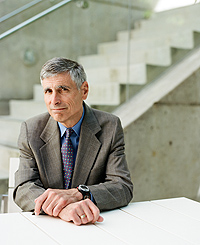SUMMER 2010 CONTENTS
Home
Transformers
How teaching hospitals could lead medicine’s metamorphosis
No holes barred
Interest grows in using natural openings for surgery
The healing hand
Putting the physical back in the physical exam
Take the tube
Mass transit for lab samples
Code green
New hospitals blend healing and conservation
On the record
The nation’s health information technology leader on the future of patient data

DOWNLOAD PRINTABLE
ISSUE (PDF)


Leslie Williamson

For those who, like myself, believe the health-care system is desperately in need of reform, the passage by Congress of national reform (the Patient Protection and Affordable Care Act) is cause for at least some celebration.
The effort to reform the nation’s health-care system, begun in the modern era with Truman and having failed under the leadership of numerous U.S. presidents, has finally come to fruition. After decades of political effort and public debate — sometimes inspiring, sometimes discouragingly uninformed — legislation with major implications for the insurance industry and the public entitlement programs is now the law of the land.
President Obama’s signing of the legislation on March 23 marked a new beginning. While the recent legislation, which will unfold over the next five and more years, is broad in its sweep, it does relatively little to control costs or to reform the service delivery side of the equation. So, much work remains to be accomplished.
Ultimately the shape of the nation’s health-care system will depend on individual leaders, innovative research and education, and changes in culture that address how we care for patients in the hospital, in ambulatory settings, at home and in their communities. It’s an enormous challenge and I believe Stanford’s community of scholars, researchers and clinicians has much to contribute.
A new endeavor we are launching this summer holds extraordinary promise for that effort. The Clinical Excellence Research Center, to be directed by acclaimed health-care policy expert Arnold Milstein, MD, aims to accelerate innovations in health-care delivery. Dr. Milstein will lead research teams seeking to discover and refine clinical service innovations that will enhance health, increase patient satisfaction and lower annual per-capita health-care spending.
The teams will take advantage of the prowess of the university at large — they will be composed of faculty from the business, engineering and medical schools as well as Stanford Hospital & Clinics, which is also supporting this new initiative.
Teaching hospitals like ours are in a unique position during this time of transition — ideally positioned to offer solutions, yet particularly embattled by the new economic realities. This issue of Stanford Medicine describes some of the struggles and advances taking place at our teaching hospitals, which I believe are in many ways emblematic of the approximately 400 others in the nation. Some highlights in this issue include an examination of how teaching hospitals are responding to change in the system, a conversation with the federal chief of health information technology and our efforts here to reinvigorate the bedside exam.
Despite reform in our country, the health-care system continues to function under extreme tension. As a nation, we still grapple with high costs and the growing recognition that some dimensions of quality of care fall short. Yet the genomic revolution and the work of biomedical and clinical researchers are paving the way for breathtaking advances in medicine. Undeniably, this is a most exciting time to be in medicine. The challenges are daunting; the potential for improving human welfare is dramatic.
Ultimately our success will be measured by how we are able to achieve state-of-the-art patient care fueled by innovation and discovery and delivered with high-quality service and as low a cost as possible. I hope our new Clinical Excellence Research Center will help us achieve these important goals.
Sincerely,
Philip A. Pizzo, MD
Dean
Stanford University School of Medicine
Carl and Elizabeth Naumann Professor, Pediatrics, Microbiology and Immunology

